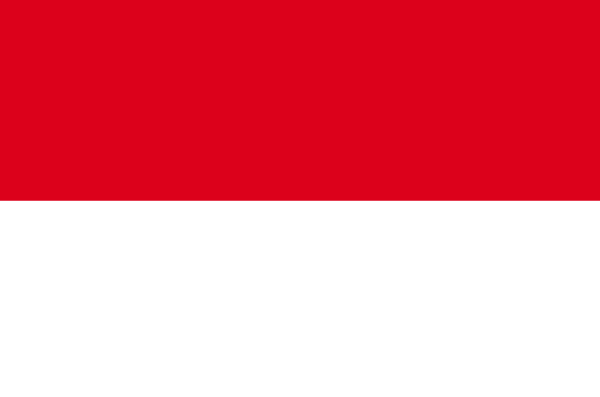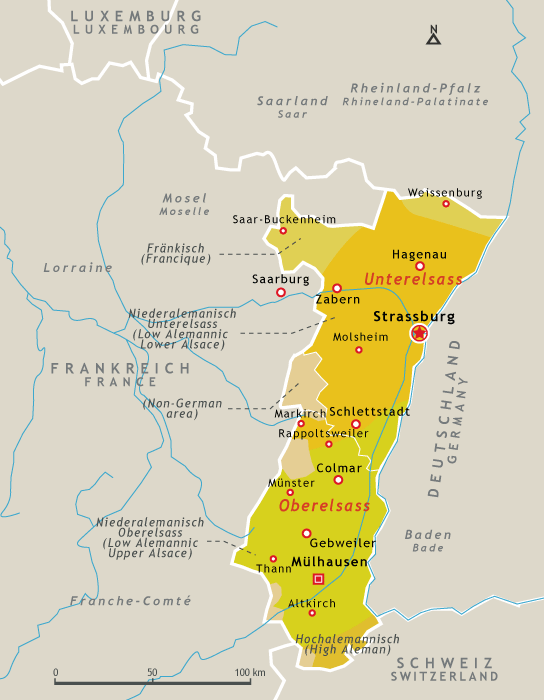Alsace, land of the Alamanni

Alsace is a former geographical reality, but its political unity is relatively recent. Since the 19th century, Alsace has been trying to assert its identity between two great powers – France and Germany – who covet the territory for its wealth.

The Alsatian flag carries the name of Rot un Wiss (red and white). These colours are present in the coat of arms of cities and Alsatian families. The Rot un Wiss appeared towards 1872, to affirm the Alsatian identity, with regards to the German authorities and then the French. It was made official by the Alsace-Lorraine parliament in 1912.
The Alsace people arose slowly during the Middle Ages. In this century, Alsace was primarily a geographical and cultural reality and non-political because its territory was divided up into fiefs under the authority of the Holy Roman Empire. The Franco-Germanic Wars (1870–1, 1914–18 and 1939–45) placed Alsace between the two great powers. Alsace became a political reality after its annexation to the German Empire in 1871 and in 1911 it acquired autonomous status. After 1918, Alsace led a staunch fight against the central French state to maintain its characteristics. In this century, two-thirds of the Alsace deputies were autonomist. Unfortunately, after the Second World War, in cultivating the amalgam “Alsace = Nazi”, the French state accelerated its policy of assimilation.
The Alsatian people are a Germanic people, who could be considered southern Germans.
Today, Alsace is once more a rich region, benefitting from locally specific law and a German dialect that still persists. However, these elements are threatened by the Jacobean character of the French state, which isolates it from the Rhine area. The Alsatian people work hard to make their demands heard even if German is taught nowadays in the schools. Moderate separatist movements have begun to emerge, raising awareness of the specificity of Alsatian culture and promoting interest in preserving it.

Identity card

| Name | Elsass | German Alsace | French |
| Population | 1,895,811 inhab. (2020) |
| Area | 8,280 km² |
| Languages | Elsässisch | Alsatian (Germanic and Franconian variant of German, used as a written standard) (without official status) Français | German(official) |
| Number of native speakers | 800,000 | Alsatian (2014) |
| State of guardianship | France |
| Official status | European Collectivity |
| Capital | Strossburi | Alsatien Straßburg | German (Strasbourg) |
| Historic religion | Roman Catholic and Protestant, Jewish |
| Flag | Rot un Wiss | Alsatian Rot und Weiß | German (Red and White) |
| Anthem | Elsässisches Fahnenlied | German (Song of the Alsatian Flag) |
| Motto | None |

Timeline

- 378 • The Alamans and the Franks drive out the Romans. Alsace is at the centre of Alamannia.
- 9th–10th century • Treaty of Verdun and the Treaty of Mersen: Alsace is successively incorporated into Lorraine and then the Germanic Holy Roman Empire.
- 1648 • Annexation of Alsace to France. Alsace has to leave the Holy Roman Empire.
- 1871 • Franco-Prussian War: Alsace and Moselle are incorporated into the German Empire.
- 31 May 1911 • Alsace-Lorraine obtains politically autonomous status.
- 1914–18 • The Alsatians fight in the German army. French victory in 1918. Expulsion of Alsatians under ethnic criteria.
- 24 May 1926 • Creation of the Home Federation, structure of political coordination for obtaining autonomous status.
- 1939–45 • Deportation of part of the population of Gascogne. Annexation of Alsace by the Third Reich. Liberation in 1944–5.

Brief history

On 8 May 1926, the manifesto of the Home Federation appeared in the Alsatian newspaper Die Zukunft. Published by representatives of moderate and autonomist parties, it called for autonomous status for Alsace. In response, Paris launched an unprecedented wave of repression: banning newspapers, laying-off staff and making arrests. On 22 August 1926 in Colmar, an autonomist parade fell into a trap prepared by police and royalists: separatist protesters were violently attacked and arrested (Bloody Sunday). On Christmas night 1927, the main autonomists responsible were arrested and incarcerated for “conspiracy against state security”. Convicted without evidence in Colmar, they were then released by the Assize Court of Besançon.

Geography

Alsace is a region stretching from the north to the south along the Rhine valley. It is defined to the east by the Rhine (Baden), to the west by the crest of Vosges (France), to the north by the river Lauter (Palatinate) and to the south by the Jura mountains (Switzerland). It consists of many different areas: the plain of Alsace, drained by the river Ille, the marshy area of Ried, which lies between the Rhine and the Ille marking the former floodplain of the Rhine, the Vosges mountains (highest point: Grosser Belchen/Grand Ballon 1, 424 m). Two metropolises, Strasbourg and Mulhouse, shine on the two historic regions of Low and Upper Alsace. Comprising a network of average-sized towns (Guebwiller, Colmar, Sélestat, Saverne), the Vosges are home to vineyard, of worldwide repute.



Language

Elsässerditsch
Alsatian (Elsässerditsch) is a collection of Germanic variants. The most important of these dialects is Low German (also spoken in Baden), used in the largest part of Alsace. High German is used equally in the south of Alsace. Alsatian has been spoken since the 6th century. Since the 16th century, standard German (High German) comprises the written expression of Alsatians, according to the same principle in Switzerland for example. More than 80,000 students learn it including 50,000 in primary bilingual education. This enthusiasm for German is understandable due to the historical ties the Alsatians maintain with this language. An edition of the newspaper Dernières Nouvelles d’Alsace comes out each day in this language (10% circulation). This favourable situation shouldn’t hide the fact that, as a written standard, Alsatian German does not have an official status in France.

Politics now

Today, Alsace is considered a French region. In this context, certain areas have a specific law, a unique situation for a metropolitan region, except for the case of the Territorial Collectivity of Corsica. Moreover, to national law is added a local law which specifically concerns greater municipal autonomy, a right to work and a more advantageous social system (social security) as well as a specific system for religious worship, hunting, justice etc. Despite this interesting heritage, the autonomist parties (of those the former People’s Union of Alsace) poll modestly, often becoming the opposition of the far-right (Alsace First; ADA), who coat themselves in a regionalist sheen. The formation of a new political force in 2009 (Unser Land), uniting the UPA and the dynamic association “Fer’s Elsass”, could give new impetus to Alsatian autonomism.
Principal Alsatian parties
- Unser Land (Our Country) (Autonomist, Social Democrat)

